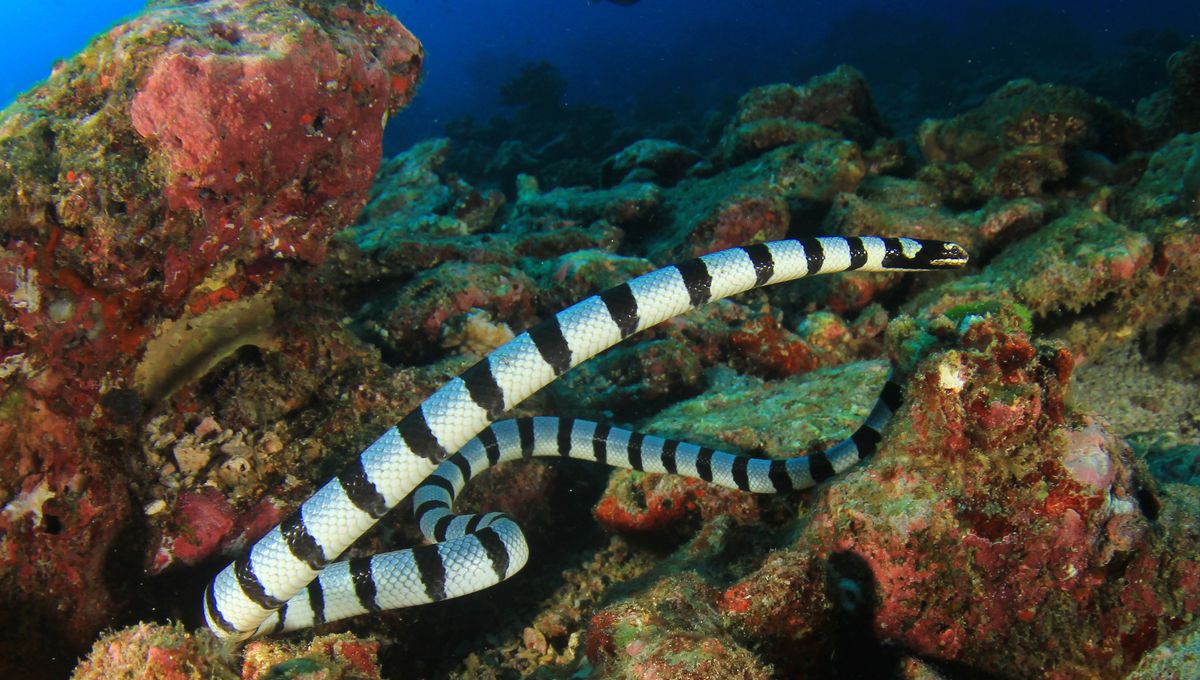
A strange video that appears to show an eel shedding off a rather nice striped sweater has been doing the rounds on TikTok, and the video’s twist ending has got a lot of people thoroughly confused, concerned, and disgusted.
The video, which is filmed beside a rocky coral bank on the seabed, shows what looks like a large snake shedding its skin; however, once removed, the “skin” gains sentience and swims off, leaving behind a near-lifeless eel.
What’s really happening though, is quite a lot sadder. The stylish striped sweater is actually a banded sea krait (Laticauda colubrina), also known as a yellow-lipped sea krait, which has used its potent venom to attack and attempt to eat a large Moray eel.
But, after likely being spooked by the camera, the snake regurgitated its meal before fleeing the scene, leaving the partially paralyzed eel to die on the seabed. Surprisingly, this isn’t the only footage of banded sea krait regurgitating a Moray eel, as a similar scene was captured in Palau’s barrier reef by diving company Neco Marine Palau in 2023.
A highly venomous species, the banded sea krait spends much of its time in coral reefs in the coastal waters of the eastern Indian and western Pacific oceans. But, unlike “true” sea snakes, banded sea kraits are only semi-aquatic, emerging from the water at 10-day intervals to lay eggs, shed their skin, and digest food. After eating a large meal at sea, banded sea kraits will emerge back onto land where they digest their food over the course of several days.
Growing to an impressive size of 1.28 meters (4.2 feet) in the case of the females, these deadly serpents use their potent venom, which is 10 times more toxic than a rattlesnake’s, to paralyze their predominantly eel-based prey before swallowing them whole. While most snakes consume their prey head-first, these guys prefer to tackle their dinner tail-first, leaving the eel’s semi-lucid head to put up one hell of a fight.
While not classified as endangered, banded sea snakes are relatively rare to see and are distinguished by their latterly compressed, paddle-like tails and thick black bands on their otherwise white/grey body. They’re in the family Elapidae, which consists of around 300 venomous species including cobras, coral snakes, and taipans.
With the ability to hold their breath for up to two hours, banded sea kraits have bodies which are perfectly adapted for both sea and land. Their flat tails propel them along in the water while their rough belly scales help them move on land and in trees. They have a salt gland underneath their tongue to expel salt buildup, and they can both absorb oxygen and expel the majority of their carbon dioxide through their skin.
Some believe that banded sea kraits are harmless to humans as their heads are too small to latch onto human skin, but this is very untrue. Not only could a banded sea krait land a good bite on a human, it would also take only a fraction of its 10-15 milligram venom store to land you in hospital. They are, however, said to be a surprisingly docile species with bites mostly occurring when they are accidentally caught in fishing nets.
While their IUCN red list rating is of “least concern”, sea temperature changes affecting coral reefs, coastal construction, and the destruction of their land-based homes mean banded sea kraits may one day too suffer the effects of climate destruction.
Source Link: Watch This Bizarre Footage Of A Moray Eel Wearing A Sea Snake Suit